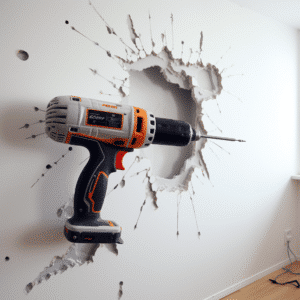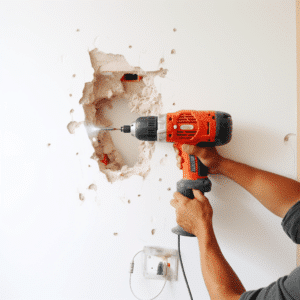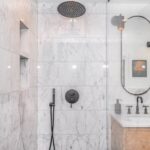Drilling Holes for Apartment Wall, person loves to feel homey in their own space. To achieve the uniqueness and style that you prefer, options like swapping out ancient paintings with new ones, new décor, or shelving will help bring a fresh appeal while creating more storage to a home.
If you’re in a rented apartment, you want to make it feel like home by hanging photos and other wall décor. But are you allowed to drill holes in your apartment?
Yes, you can drill holes; however, remember that you must fix the changes before moving out, pay for the damages, or give in your security deposit. For more details on the topic, read through our subsequent sections. Let’s jump in.
Table of Contents
Can You Drill Holes In Apartment Walls? What Would be the Use?

Hanging Pictures
A genuine reason you would want to put holes on the wall is to hang pictures, shelves, and other wall decorations to aid in personalizing your space to mark your style.
The standard option to achieve that is by driving some nails into the wall, yielding holes in the wall.
TV Mounting
Mounting your high-definition TV to your apartment walls makes your space look cleaner, boosts your room décor, and it is a trendy style. Also, purchasing a mounting TV kit is more affordable than a TV stand that sits on the floor.
Because of the TV weight, it is crucial to drill into studs in your rented house’s walls. Then secure the mounting kit with screws.
New window curtains/ Blinds
Most apartments feature affordable, ordinary, and generic window blinds for they are cost-effective to the landlord. They get to provide their tenants with the required privacy and save money.
Nonetheless, the blinds may not be your preference, so you may want new blinds or pull up the curtains. These changes demand some hole drilling into the walls and maybe into the window trim, which is hard to patch.
Most curtain rods need you to drill at least three holes in the wall or further, up to 6/7. Curtains are tricky to install as you must ensure all brackets are on the same level. As a result, ensure that you drill correctly into studs, which entails a lot of work and repair.
What Do You Need To Know Before Drilling Into The Wall?
Before you embark on any drilling project, it is crucial to understand what is behind the walls to avoid damaging the house or even risking your life. Most homeowners have multiple pipes and wires running through the house walls.
Hence, before you get the drill ready, below are a few factors to consider to help you know where to drill and safety essentials to avoid a tragedy.
Watch on Sockets and Light Sockets
The most vital risk of drilling holes into the walls is bumping into an electrical wire, water, or gas pipes as they can lead to electrocution or flooding.
Fortunately, the number one rule is to avoid drilling around switches and switches as electrical wires may be horizontal or vertical near these fixtures. Alternatively, you can look at the attic and basement through framing to establish where the cables and pipes run.
Use a Stud Finder
Invest in the correct stud finder to help locate studs (vertical beams that frame and support your house). Therefore, please turn it on, then horizontally move it until it signals a stud.
Mark the stud location and carry along the wall to find more studs if needed because they offer robust support for objects to anchor better in the wall than drywall. This exercise doesn’t take long as studs are traditionally 16-24 inches apart.
Take note that electrical wires run vertically along the vertical beams.
Use either an electronic or battery-powered stud finder. Ensure the batteries have a full charge, as low batteries can cause errors.
Avoid using magnetic stud finders, which are inaccurate at home due to a lack of metal studs but perfect for commercial buildings.
Walls Connecting To Your Bathroom or Kitchen
To find wires is pretty direct compared to pipes. The only rule is to be cautious when drilling on the bathroom or kitchen walls, for they probably have tubes, and if you find one, you will notice it as they offer some amount of resistance, thus deflecting off your drill unless you hit it where it passes via a stud.
Involve a Professional
If you are hanging heavy objects, it is best to engage an expert to rule out any inconsistencies behind the walls and determine the stud’s thickness and how the wires connect.
Be aware that dry walls aren’t as supportive as concrete or brick. Therefore, to prevent vital accidents and other risk exposures, call on a professional to help you.
How to Repair Holes in an Apartment Wall

If you have already drilled holes in the wall and have been penalized for it, you can fix them yourself. However, the type of wall in question will determine the repair method but below is the most straightforward option.
Tools
- Sandpaper
- Spackling paste
- Paint
- Putty Knife
First, sand the hole and its surroundings.
Second, fill the hole with some spackling paste using a putty knife. For larger holes, apply multiple layers of spackling paste while ensuring each layer is left to dry before applying a fresh one.
In the third step, carefully remove the paste area without applying much pressure on it for a smooth finish.
Finally, you can give the area a spotless finish with paint to cover the patch.
The paint you buy has to blend with the one on the wall
What Are Other Alternatives There other Than Drilling Holes?
- Monkey hooks
- Adhesive strips
- Hang on a bookshelf
- Adhesive hooks
- Lean on the apartment walls
You can typically drill holes in an apartment wall. But it is your responsibility to fix the barriers to their original condition, failure to which your landlord has a right to place a penalty or cut down your repair costs from your security deposit.
It is wise to seek permission from your landlord first, as drilling holes in the walls tends to weaken the security system.


